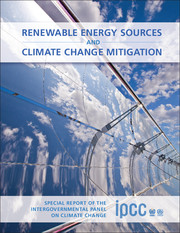 Renewable Energy Sources and Climate Change Mitigation
Renewable Energy Sources and Climate Change Mitigation Published online by Cambridge University Press: 05 December 2011
Executive Summary
All societies require energy services to meet basic human needs (e.g., lighting, cooking, space comfort, mobility, communication) and to serve productive processes. For development to be sustainable, delivery of energy services needs to be secure and have low environmental impacts. Sustainable social and economic development requires assured and affordable access to the energy resources necessary to provide essential and sustainable energy services. This may mean the application of different strategies at different stages of economic development. To be environmentally benign, energy services must be provided with low environmental impacts and low greenhouse gas (GHG) emissions. However, 85% of current primary energy driving global economies comes from the combustion of fossil fuels and consumption of fossil fuels accounts for 56.6% of all anthropogenic GHG emissions.
Renewable energy sources play a role in providing energy services in a sustainable manner and, in particular, in mitigating climate change. This Special Report on Renewable Energy Sources and Climate Change Mitigation explores the current contribution and potential of renewable energy (RE) sources to provide energy services for a sustainable social and economic development path. It includes assessments of available RE resources and technologies, costs and co-benefits, barriers to up-scaling and integration requirements, future scenarios and policy options.
GHG emissions associated with the provision of energy services are a major cause of climate change. The IPCC Fourth Assessment Report (AR4) concluded that “Most of the observed increase in global average temperature since the mid-20th century is very likely due to the observed increase in anthropogenic greenhouse gas concentrations.”
To save this book to your Kindle, first ensure no-reply@cambridge.org is added to your Approved Personal Document E-mail List under your Personal Document Settings on the Manage Your Content and Devices page of your Amazon account. Then enter the ‘name’ part of your Kindle email address below. Find out more about saving to your Kindle.
Note you can select to save to either the @free.kindle.com or @kindle.com variations. ‘@free.kindle.com’ emails are free but can only be saved to your device when it is connected to wi-fi. ‘@kindle.com’ emails can be delivered even when you are not connected to wi-fi, but note that service fees apply.
Find out more about the Kindle Personal Document Service.
To save content items to your account, please confirm that you agree to abide by our usage policies. If this is the first time you use this feature, you will be asked to authorise Cambridge Core to connect with your account. Find out more about saving content to Dropbox.
To save content items to your account, please confirm that you agree to abide by our usage policies. If this is the first time you use this feature, you will be asked to authorise Cambridge Core to connect with your account. Find out more about saving content to Google Drive.